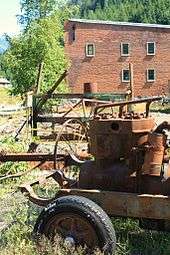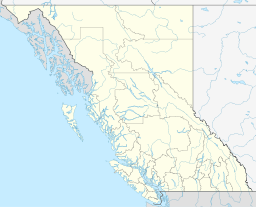Sandon, British Columbia
| Sandon | |
|---|---|
 Sandon Location of Sandon in British Columbia | |
| Coordinates: 49°58′32″N 117°13′38″W / 49.97556°N 117.22722°WCoordinates: 49°58′32″N 117°13′38″W / 49.97556°N 117.22722°W | |
| Country |
|
| Province |
|
| Elevation | 457 m (1,499 ft) |
| Population (2016) | |
| • Total | 6 |

Sandon is a ghost town in the Kootenay region of British Columbia, Canada. Once the unofficial capital of the mining region known as the "Silvery Slocan", only some of it remains standing.
Location
Sandon is located in the Selkirk Mountains, about ten kilometers east of the town of New Denver.
History
After the discovery of vast amounts of galena ore here by Eli Carpenter and Jack Seaton in 1891, prospectors flocked from around North America to stake their claims. Sandon was incorporated as a city on January 1, 1898[1] and for a few years had more than 5000 residents, brothels and a booming economy.[2] Two different railways raced to reach the town first; the Kaslo & Slocan Railway, connecting Sandon with nearby Kaslo, on Kootenay Lake, and the Nakusp & Slocan Railway-Canadian Pacific, from New Denver and Nakusp. Significant acts of sabotage were committed upon both railroads. Well into the 1900s, the hills around Sandon were actively mined by mines such as the Silversmith, the Slocan Star and The Payne. Smaller communities, such as Cody and Three Forks appeared on the map, continuing to provide opportunity to the miners. Like the other silver towns of the era, Sandon faded with the silver prices, and in 1955, a massive flood of Carpenter Creek occurred, destroying most of the remaining buildings. After the flood, looters tore apart the remains of many of the buildings.[2]
Sandon was used as a Japanese Canadian internment camp during World War II.[2]
Local Historian Bill Barlee believes there are about 10,000 coins lying somewhere along the bed of Carpenter Creek. The Creek ran through Sandon. The creek flooded in 1955. The main street of Sandon was built over the creek. It is believed coins were washed into creek from under the boardwalk along main street during the flood. The coins lie along a stretch of the creek measuring no more than a one-third of a mile in length in about 3 feet of water.[3]
Currently, Sandon features a few buildings, a fleet of trolley buses, and a handful of residents. Both railways that served the town have been dismantled and turned into hiking trails, leaving only traces of a rich mining history. There is a museum run by the Sandon Historical Society in the old mercantile building.[2] 20,000 visitors come to Sandon yearly.[2]
Television
Sandon was featured on the historical television series Gold Trails and Ghost Towns, Season 1, Episode 1.
Notable Sandonites
Sandon was the birthplace of hockey Hall of Fame member Cecil "Tiny" Thompson.
See also
References
- ↑ From Boom to Bust in 20 Years: Sandon's History as an Incorporated City, Social History subsection, Sandon Museum website, The city was disincorporated in 1920.
- 1 2 3 4 5 Mackie, John (4 April 2008). "Population: 6. Number of trolley buses: 8". The Vancouver Sun. Retrieved 19 November 2010.
- ↑ N.L. Barlee (1976), Historic Treasure and Lost Mines of British Columbia. Canada West Publications.
- May, Dave. Sandon: The Mining Centre of the Silvery Slocan, Self Published. 1983.
- Pellowski, Veronika. Silver, Lead and Hell: The Sandon Story. Sandon Historical Society. 1991.
- Sandon of the Silvery Slocan, 27 minute 1973 film, Sandon Canada DVD.
- "Sandon". BC Geographical Names.
- Barlee N.L. 1976 Historic Treasures and Lost Mines of British Columbia. Canada West Publications.
